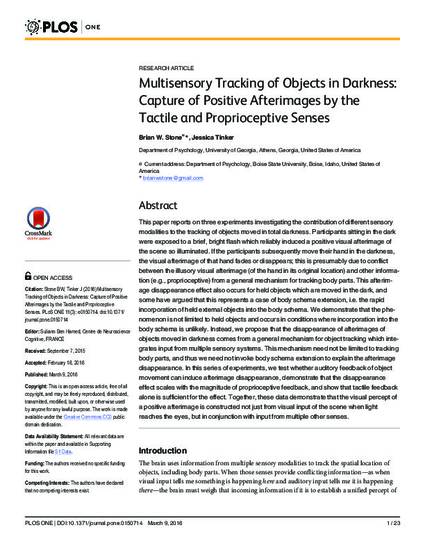
Article
Multisensory tracking of objects in darkness: Capture of positive afterimages by the tactile and proprioceptive senses.pdf
PLOS ONE
(2016)
Abstract
This paper reports on three experiments investigating the contribution of different sensory modalities to the tracking of objects moved in total darkness. Participants sitting in the dark were exposed to a brief, bright flash which reliably induced a positive visual afterimage of the scene so illuminated. If the participants subsequently move their hand in the darkness, the visual afterimage of that hand fades or disappears; this is presumably due to conflict between the illusory visual afterimage (of the hand in its original location) and other information (e.g., proprioceptive) from a general mechanism for tracking body parts. This afterimage disappearance effect also occurs for held objects which are moved in the dark, and some have argued that this represents a case of body schema extension, i.e. the rapid incorporation of held external objects into the body schema. We demonstrate that the phenomenon is not limited to held objects and occurs in conditions where incorporation into the body schema is unlikely. Instead, we propose that the disappearance of afterimages of objects moved in darkness comes from a general mechanism for object tracking which integrates input from multiple sensory systems. This mechanism need not be limited to tracking body parts, and thus we need not invoke body schema extension to explain the afterimage disappearance. In this series of experiments, we test whether auditory feedback of object movement can induce afterimage disappearance, demonstrate that the disappearance effect scales with the magnitude of proprioceptive feedback, and show that tactile feedback alone is sufficient for the effect. Together, these data demonstrate that the visual percept of a positive afterimage is constructed not just from visual input of the scene when light reaches the eyes, but in conjunction with input from multiple other senses.
Keywords
- multisensory,
- vision,
- audition,
- tactile,
- proprioceptive,
- body schema,
- afterimages
Disciplines
Publication Date
Spring March 9, 2016
Citation Information
Brian Stone and Jessica Tinker. "Multisensory tracking of objects in darkness: Capture of positive afterimages by the tactile and proprioceptive senses.pdf" PLOS ONE (2016) Available at: http://works.bepress.com/brian-stone/4/
